Land Invertebrates
Media
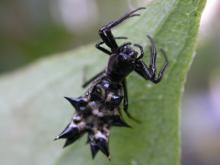
Species Types
Scientific Name
Micrathena gracilis
Description
The color pattern can vary, but the ten-spined, chunky abdomen sets the female spined micrathena apart from all other spiders.
Media
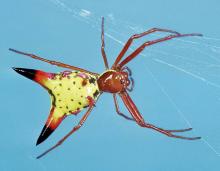
Species Types
Scientific Name
Micrathena sagittata
Description
One of three micrathena spiders in Missouri, the arrowshaped micrathena is small but unforgettable. Females have striking reddish, black, and yellow colors, and a pair of outward-pointing tubercles at the end of the body give it a triangular or "arrow" shape.
Media

Species Types
Scientific Name
Panorpa spp.
Description
Male scorpionflies will make you look twice, because the abdomen is tipped with what looks like a scorpion stinger! These nifty insects cannot sting, however.
Media

Species Types
Scientific Name
Neoscona arabesca
Description
The arabesque orbweaver is a common orb-weaving spider in Missouri. The coloration is quite variable, but the slanting dark marks on the abdomen help to identify it.
Media

Species Types
Scientific Name
Rabidosa punctulata
Description
The dotted wolf spider has a solid brown stripe running down the middle of the abdomen, seen from above. Like other wolf spiders, females have strong maternal instincts, carrying their spiderlings around on their back until they can be on their own.
Media

Species Types
Scientific Name
Tigrosa aspersa
Description
A speckled wolf spider usually seems larger than it actually is. It's one of Missouri's more common species of wolf spiders. Mothers have remarkable maternal instincts and are often seen carrying their young around on their abdomen.
Media

Species Types
Scientific Name
Araneus marmoreus
Description
The marbled orbweaver is sometimes called the “pumpkin spider” because its rounded abdomen is sometimes bright orange. The color and markings can vary greatly.
Media
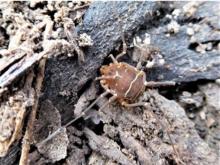
Species Types
Scientific Name
Members of suborder Laniatores
Description
Armored harvestmen have spines on their fingerlike mouthparts (pedipalps). Unlike other harvestmen, members of this suborder of so-called daddy longlegs do not usually have long legs.
Media
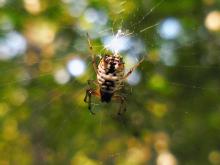
Species Types
Scientific Name
Micrathena mitrata
Description
The white micrathena has 2 short pairs of tubercles and a white abdomen with a few distinct black blotches on the upper side. In an odd way, it looks like it's wearing a turban. This is one of three Missouri species of micrathenas, also called spiny orbweavers.
Media
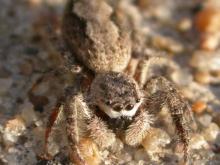
Species Types
Scientific Name
Platycriptus undatus
Description
The tan jumping spider usually lives on tree trunks. Its gray, tan, and brown coloration camouflages it against tree bark. There is usually an undulating pattern on the abdomen.
See Also



Media

Species Types
Scientific Name
Cisseps fulvicollis
Description
The yellow-collared scape moth is more often “orange-collared.” And whether you think it looks more like a firefly or a wasp, it’s still a moth!
Media

Species Types
Scientific Name
Nearly 150 species in North America north of Mexico
Description
Slim, delicate plume moths are instantly recognizable by their T-shaped silhouette, long legs, and muted shades of tan and brown. It can be hard to separate the various species.
Media

Species Types
Scientific Name
Pyrrharctia isabella
Description
Not many people know the adult Isabella tiger moth when they see one, but we’re all acquainted with its caterpillar, the woolly worm, or woolly bear.
About Land Invertebrates in Missouri
Invertebrates are animals without backbones, including earthworms, slugs, snails, and arthropods. Arthropods—invertebrates with “jointed legs” — are a group of invertebrates that includes crayfish, shrimp, millipedes, centipedes, mites, spiders, and insects. There may be as many as 10 million species of insects alive on earth today, and they probably constitute more than 90 percent all animal species.





















